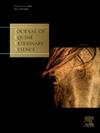Correlation between hematological and morphometric parameters with seminal traits and post-thaw sperm viability in stallions
IF 1.3
3区 农林科学
Q2 VETERINARY SCIENCES
引用次数: 0
Abstract
This study evaluated the correlation between hematological parameters (hemoglobin (Hemo), hematocrit (Hema), blood urea nitrogen (BUN), creatinine (Cre), total protein (PT), and albumin (Alb), morphometric (cervical skinfold thickness (PCmm), body condition score (BCS), weight (PB), and ultrasound assessments of fat thickness on hip (EG) and tail base (EC), and body fat percentage (PGC), and sperm viability of post-thaw (total progression (PTfr), total motility (MTfr), and sperm concentration (Confr) in stallions from the National Police Horse Breeding Center located in Facatativá, Colombia. Twelve stallions (Argentine saddle, French saddle, Friesian, Belgian, Percheron, KWPN), aged between 5 and 14 years, were incluced and their semen was diluted with two extenders (modified INRA-82 and Botucrio). Within the morphological parameters to be considered in breeding males we have the BSC due to its significant influence (ANOVA) on the VCL showing a negative Pearson correlation of -0.41 for INRA and -0.45 for Botucrio presenting optimal performances when comparing the means (LSD test) in a BSC valued at 6, in the same way the same behavior is observed for VSL (Correlation of -0.46 for INRA and -0.34 for Botucrio) and for VAP (Correlation of -0.43 for INRA and -0.44 for Botucrio). Similarly, correlations of -0.68 are presented for INRA while for Botucrio it was estimated at 0.03 between EC and BCF identifying an ideal fat cover for EC<2.4 mm. Another parameter that significantly affects negatively is PGC being the ideal <15.6%, this variable affects the BCF showing a correlation of -0.69; for Botucrio it was calculated at 0.03, which suggests that Botucrio's performance is better under fattening, however statistically there is no significant difference probably due to the number of specimens used. On the contrary the EG is directly proportional to VCL with a correlation of 0.35 for INRA and 0.39 for Botucrio, VSL correlations of 0.38 INRA and 0.28 Botucrio, and VAP a correlation of 0.37 INRA and 0.33 Botucrio, showing greater efficiency with a fat cover >2.4 mm; On the other hand, within the hematological parameters it was observed that Hemo with values ≥16 g/dl improves the performances for VCL (Correlations of 0.26 INRA and 0.40 Botucrio), VSL (Correlations of 0.43 INRA and 0.33 Botucrio) and VAP (Correlations of 0.33 INRA and 0.38 Botucrio), this leads to think that inducing hyper oxygenation prior to seminal collection improves these parameters post-thawing, finally, Cre with levels ≥1.8 mg/dl favor VCL (Correlations of 0.39 INRA and 0.41 Botucrio) and BCF (Correlations of 0.39 INRA and 0.48 Botucrio).
求助全文
约1分钟内获得全文
求助全文
来源期刊

Journal of Equine Veterinary Science
农林科学-兽医学
CiteScore
2.70
自引率
7.70%
发文量
249
审稿时长
77 days
期刊介绍:
Journal of Equine Veterinary Science (JEVS) is an international publication designed for the practicing equine veterinarian, equine researcher, and other equine health care specialist. Published monthly, each issue of JEVS includes original research, reviews, case reports, short communications, and clinical techniques from leaders in the equine veterinary field, covering such topics as laminitis, reproduction, infectious disease, parasitology, behavior, podology, internal medicine, surgery and nutrition.
 求助内容:
求助内容: 应助结果提醒方式:
应助结果提醒方式:


